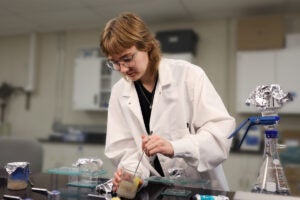Millions of people have walked on the hallowed ground of the Alamo, touching the walls of the shrine where heroes like Davy Crockett, James Bowie and William Travis once fought for freedom.
The limestone walls of the old church building, known today as “The Shrine of Texas Liberty,” dedicated to the men who fell in defense of the Alamo,” have not been cleaned in about 250 years and it shows.
More than 2.5 million people visit the Alamo each year and the millions of hands that have touched the walls of the shrine have left a build-up of oily film and dark stains.
The Daughters of the Republic of Texas and the Alamo’s staff felt it was time to spruce up the shrine and called upon Ford, Powell and Carson Architects in San Antonio to make it happen. The firm is the preservation architect for the Alamo as well as several other San Antonio missions.
Bruce Winders, curator of the Alamo, said the cleaning project was needed for a long time but six months ago plans were finally set to get it started and at just the right time Casey Gallagher, a graduate student in the School of Architecture’s Historic Preservation Program, was searching for a summer internship.
She nabbed the job with Ford, Powell and Carson at a university internship fair. In addition to the Alamo, Gallagher worked on Mission Concepcion and assisted with analysis of historical buildings and architectural work.
The first step in the Alamo project was to find a cleaner to use and in June Gallagher worked on testing different cleaners. The team chose one designed specifically for historic masonry that was also the most gentle.
The cleaning process involves applying a mixture of water and the chemical with a sponge or paint brush, leaving it on for about five minutes and then scrubbing it with a soft-bristled brush.
The scrubbing began in August with Gallagher and the Alamo staff taking on the arduous task of cleaning the interior walls up to five feet high.
“It was scary at first,” Gallagher said. “The first day I got to work I checked and rechecked spots to make sure it wasn’t doing any harm. When you scrub the wall it turns into a gray froth. You can see a dramatic difference when you are finished.”
Due to the delicate nature of the historic masonry, only small brushes can be used, with conservators and volunteers working on small areas each day, resulting in a very labor intensive process.
Luckily, Gallagher wasn’t the only Longhorn with a thirst for hands-on experience.
As her summer internship came to a close and the cleaning work wasn’t finished, Gallagher organized a team of 12 classmates to serve as Alamo volunteer conservators over a three-day period. Many of the volunteers were first-year graduate students just starting out in the historic preservation program.
Deepthi Murali, of India, volunteered to help clean the Alamo on Aug. 29 with three other first-year historic preservation graduate students.
Murali decided to study historic preservation because it’s a field she sees a great need for in her country.
“America, with just 300 years of history, is doing historic preservation well while India has 1,000 years of history and there are no preservationists,” she said. “When architects in India come across a building they break down that building to build a newer one when they could have redone it.”
Li Tong, of China, also said historic preservation is lacking in her country.
“We have 5,000 years of history but most buildings are only about 50 years old,” she said. “Students there don’t care about tradition and historical sites. We have to do something to preserve what we have.”
In San Antonio, people are constantly evaluating the state of the Alamo and determining what else can be done to keep it in good condition. Once the walls have been cleaned a poultice will be applied to draw the salts out of the stone. Limestone is a very porous stone and can absorb water readily. The water absorbed from the soil contains salts that can damage historic masonry.
Gallagher said she is proud and honored to have worked on the Alamo and feels the work she and other students did is important.
“The Alamo is an icon that a lot of people care about,” she said. “There is a lot of work that goes into keeping it in good shape and even though what we are doing is a small piece of the puzzle, it is important.”



